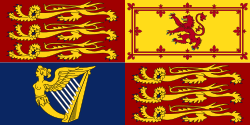Palace of Placentia

Der Palace of Placentia war ein englischer Königspalast.
Geschichte
Humphrey, Duke of Gloucester, ließ von 1426 bis 1437 am Südufer der Themse bei Greenwich ein Schloss bauen, das Bella Court genannt wurde. Nachdem Humphrey 1447 wegen Hochverrats angeklagt wurde und unter ungeklärten Umständen gestorben war, fiel der Palast an Königin Margarete von Anjou. Sie benannte den Palast in Palace of Placentia um, zeitweise wurde der Palast auch als Palace of Pleasaunce beschrieben.

Der Palast wurde für die nächsten zwei Jahrhunderte einer der wichtigsten königlichen Paläste. Unter Heinrich VII. wurde der Palast um 1500 vollkommen umgebaut und wird als roter Ziegelsteinbau beschrieben. Er enthielt eine gewaltige Banketthalle, im Park befand sich ein großer Turnierplatz. 1491 wurde Heinrich VIII. im Palast geboren, in ihm heiratete er auch seine erste Frau Katharina von Aragon sowie seine vierte Frau Anna von Kleve. Der Palast war eine Lieblingsresidenz seiner zweiten Frau Anne Boleyn, die schließlich von dem Palast aus zum Tower gebracht wurde, wo sie hingerichtet wurde. Die Töchter Heinrichs VIII., Maria I. und Elisabeth I., wurden in dem Palast geboren und nutzten den Palast während ihrer Regierungszeiten als Sommerresidenz. Während der Herrschaft Jakobs I. und Karls I. wurde der Palast um das oberhalb gelegene Queen’s House erweitert, das als Lustschloss und Sommersitz für Königin Anna begonnen wurde. Während des englischen Bürgerkrieges verfiel der Palast. Einige Zeit diente er als Kriegsgefangenenlager.
1664 wollte Charles II. anstelle des alten Palasts einen Neubau durch den Architekten John Webb errichten lassen. Der alte Palast wurde dafür abgerissen und beiderseits einer auf das Queen’s House ausgerichteten Achse wurde in den 1660er Jahren der 74 Hektar große Greenwich Park nach Entwürfen von Le Nôtre angelegt. Von dem neuen königlichen Palast wurde jedoch bis 1669 nur der Ostflügel des jetzigen King Charles Blocks gebaut, bevor der Bau durch Geldmangel gestoppt wurde.[1] Erst unter Wilhelm III. wurde ab 1694 anstelle des Palastes nach Plänen von Christopher Wren das Greenwich Hospital für alte und verwundete Seeleute auf dem Gelände errichtet.
Literatur
- Ingrid Nowel: London. Biographie einer Weltstadt. Architektur und Kunst, Geschichte und Literatur (= DuMont-Kunst-Reiseführer). 4., aktualisierte Auflage. DuMont, Köln 2007, ISBN 978-3-7701-4382-5, S. 132 ff.
Weblinks
Einzelnachweise
- ↑ RIBA architecture.com from the Royal Institute of British Architects: John Webb. Archiviert vom (nicht mehr online verfügbar) am 15. Dezember 2011; abgerufen am 9. Januar 2012.
Koordinaten: 51° 28′ 56″ N, 0° 0′ 24″ W
Auf dieser Seite verwendete Medien
Autor/Urheber: Internet Archive Book Images, Lizenz: No restrictions
Identifier: historicalaccoun00cook (find matches)
Title: An historical account of the Royal Hospital for Seamen at Greenwich
Year: 1789 (1780s)
Authors: Cooke, John, 1738-1823 Maule, John, 1748-1825
Subjects: Royal Hospital for Seamen at Greenwich Royal Hospital for Seamen at Greenwich Hospitals, Naval and marine Hospitals, Military
Publisher: London : Sold for the authors by G. Nicol, Pall-Mall T. Cadell, Strand J. Walter, Charing-Cross G.G.J. and J. Robinson, Pater-Noster Row and at the chapel of the hospital
Contributing Library: Francis A. Countway Library of Medicine
Digitizing Sponsor: Open Knowledge Commons and Harvard Medical School
View Book Page: Book Viewer
About This Book: Catalog Entry
View All Images: All Images From Book
Click here to view book online to see this illustration in context in a browseable online version of this book.
Text Appearing Before Image:
u of their provifions, are prevented from expofmg themto fale elfewhere ; and though the Hofpital derives a profit,, are allowed fullas much if not more than they can otherwife make of them. They H O L. 129 They eat altogether at a Table provided for them withinthe Hofpital 3 and the following is a fcheme of their dietfor every day in the week, viz. Days. Bread.oz. 1 ; Beer.; Quarts Beef. Muttnlb. Rice Milk. Pint. PlumbPudd* lb. PeafeSoup. Pint. Butteroz. Cheefeoz. Sunday Monday Tuefday Wednefd. Thurfday Friday Saturday 14H *4 14 HH i 1 a 1a 1a I 3 4 I I I I 2222222 1 7 2 a. If I 3t 5 1 2 H Broth is allowed on each Meat day. About 2,650 Boys have been admitted from the flrilEftabli&ment to the prefent time.. After the foregoing account of the prefent fate ofthe fpot whereon feveral of our former Mo- narchs have refided^ it may not be unacceptableto our Readers to fee a Deft rip tion and View ofthe old Palace, which, by the Favour of theAntiquarian Societys we are enabled to annex*
Text Appearing After Image:
AN ACCOUNT OF T H Ancient ROYAL PALACE of PLACE NT IA I N EAST- GREENWICH R E E.N WI C H, or Grenewick, incus- viridans9,called,in ancient Deeds and other Writings, Eafl - Grenwick,,in order to diftinguifh it from Deptford, which was here-tofore called Weil-Green wick, probahly from its Situationon the verdant Banks of the Thames. Before we mention the Palace, it may not be improper togive fome Account of the Lands on which it was erected.They, together with Lewidram, Woolwich, and otherAppendages, were given to the Church of St. Peter, inGhent, by Elflrude, Niece to King Edgar, and Wife toBaldwin, Earl of Flanders, for the Health of her Soul,and the Souls of her Huiband and his two Sons, Arnulfand Adenulf. j, Dunfcan, Archbimop of Canterbury, who had been Ab-bot of St. Peters, at Ghent, is laid to have prevailed uponKing Edgar to renew and confirm the aforeiaid Grant byhis Charter, dated 964. The fame Grant was renewed,by Edward the Confeffor, William the Conqueror, HenryI, II* £ndK
Note About Images
Autor/Urheber: Eigenes Werk, Lizenz: CC BY-SA 4.0
Royal Standard of the United Kingdom


